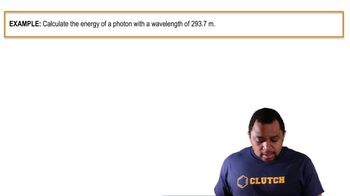Alcohol-based fuels for automobiles lead to the production of formaldehyde (CH2O) in exhaust gases. Formaldehyde undergoes photodissociation, which contributes to photo- chemical smog: CH2O + hn ¡ CHO + H The maximum wavelength of light that can cause this reaction is 335 nm. (b) What is the maximum strength of a bond, in kJ/mol, that can be broken by absorption of a photon of 335-nm light?
Ch.18 - Chemistry of the Environment

Brown14th EditionChemistry: The Central ScienceISBN: 9780134414232Not the one you use?Change textbook
Chapter 18, Problem 33d
Alcohol-based fuels for automobiles lead to the production of formaldehyde (CH2O) in exhaust gases. Formaldehyde undergoes photodissociation, which contributes to photo- chemical smog: CH2O + hn ¡ CHO + H The maximum wavelength of light that can cause this reac- tion is 335 nm. (d) Write out the formaldehyde photodis- sociation reaction, showing Lewis-dot structures.
 Verified step by step guidance
Verified step by step guidance1
Identify the reactants and products in the photodissociation reaction: CH2O (formaldehyde) breaks down into CHO and H.
Draw the Lewis-dot structure for formaldehyde (CH2O): Carbon (C) is the central atom, double-bonded to oxygen (O) and single-bonded to two hydrogen (H) atoms.
Draw the Lewis-dot structure for the formyl radical (CHO): Carbon (C) is double-bonded to oxygen (O) and single-bonded to hydrogen (H), with an unpaired electron on carbon.
Draw the Lewis-dot structure for the hydrogen atom (H): A single hydrogen atom with one valence electron.
Combine the structures to represent the photodissociation reaction: CH2O (with its Lewis structure) + h\nu \rightarrow CHO (with its Lewis structure) + H (with its Lewis structure).

Verified video answer for a similar problem:
This video solution was recommended by our tutors as helpful for the problem above.
Video duration:
5mWas this helpful?
Key Concepts
Here are the essential concepts you must grasp in order to answer the question correctly.
Photodissociation
Photodissociation is a process in which a chemical compound breaks down into smaller components due to the absorption of light energy. In the case of formaldehyde (CH2O), it absorbs photons of a specific wavelength, leading to the formation of carbon monoxide (CHO) and a hydrogen atom. This reaction is significant in atmospheric chemistry, as it contributes to the formation of pollutants like photochemical smog.
Lewis Dot Structures
Lewis dot structures are diagrams that represent the valence electrons of atoms within a molecule. They illustrate how electrons are shared or transferred between atoms, helping to visualize molecular bonding and structure. For formaldehyde, the Lewis structure shows the central carbon atom bonded to two hydrogen atoms and one oxygen atom, with appropriate electron pairs depicted to indicate bonding and lone pairs.
Recommended video:
Guided course

Lewis Dot Structures: Ions
Wavelength and Energy of Light
The wavelength of light is inversely related to its energy, as described by the equation E = hc/λ, where E is energy, h is Planck's constant, c is the speed of light, and λ is the wavelength. In the context of photodissociation, the maximum wavelength of 335 nm indicates the threshold at which formaldehyde can absorb light energy sufficient to break its chemical bonds. Understanding this relationship is crucial for predicting the behavior of molecules under light exposure.
Recommended video:
Guided course

Photon Energy Example
Related Practice
Textbook Question
1
views
Textbook Question
An important reaction in the formation of photochemical smog is the photodissociation of NO : NO2 + hv → NO(g) + O(g) The maximum wavelength of light that can cause this reac- tion is 420 nm. (a) In what part of the electromagnetic spec- trum is light with this wavelength found?
2
views
Textbook Question
An important reaction in the formation of photochemical smog is the photodissociation of NO : NO2 + hv → NO(g) + O(g) The maximum wavelength of light that can cause this reaction is 420 nm. (b) What is the maximum strength of a bond, in kJ/mol, that can be broken by absorption of a photon of 420-nm light?
